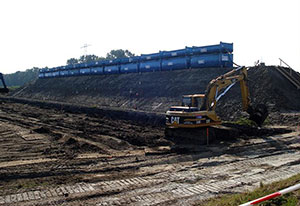

By John Karoly
Chicago, IL, USA

John Karoly
We had Sandy and a lot has been written about her already. A lot more will be written and there have been many prognostications and there will be many more. So may I put my two bits into this subject/event and try to give you my take on it.
Sandy has been compared to many other hurricanes. She was only a Category 1, which is mild, but and this is a huge but, she carried an enormous amount of water, extended for over a thousand miles and last, but not least, flooded a portion of New York City. Flooding New York high-rises, subways and tunnels is no ordinary storm. It has probably never happened in modern times that a portion of a huge city with huge buildings and subway systems have been flooded with seawater. Modern cities are not built for seawater flooding. This flood has major consequences.
Seawater, unlike potable or sweet water, contains salts which in the presence of oxygen or air corrodes most metals, especially iron and concrete reinforced with iron, or rebar. And due to the fact that water finds its way to and through the smallest of crevices, the seawater corrodes with time everything but natural materials and relentlessly so. The seawater, which seeped into tiny, sometimes microscopic openings, will remain active so long as it is in contact with air and moisture.
There is no easy way to clean up structures, subway systems and equipment flooded by the sea. It would take so much fresh water rinsing that the volume of fresh water would exceed the volume of seawater which flooded the basements, subways, etc. It would probably exceed many times the volume of seawater before anyone could be sure that all the salts have been dissolved. It would exceed any reasonable cleanup effort. Alternately, it would require a massive de-construction and re-construction.
Since such measures are not likely to be undertaken as it would take a long time, render the facilities useless and cost large sums of money, the cleanup effort maybe reduced to not more then pumping the seawater out and putting the structures and systems back into service.

For years after the event, the sea will do its insidious work. Long after Hurricane Sandy, failures will occur which will be difficult to attribute to Sandy. Any estimate in these early stages of the damage will turn out to be too small and too optimistic. There is, really, no way to estimate the damage at this point and probably it will never be accounted properly as the time will be too long and the allocation of the cause too complex and cumbersome.
After a while, we are likely to realize that we cannot afford hurricanes and flooding of this magnitude. We can carry out discussions and arguments about climate change and politically-motivated pronouncements, but at the end of the day, we need to do more than talk. Hurricanes with Sandy's characteristics or worse could come more frequently due to the accelerating warming of the seas.
Ultimately, we will probably have two choices: either relocate inland coastal communities and close down lower parts of large cities, such as Manhattan, or build large, expensive structures to protect these communities from seawater flooding.
Relocating, displacing large segments of population, relocating centuries-old institutions, saying good-bye for millions to a way of life is hardly a solution we are likely to choose. Yet doing nothing, it will rather quickly become evident, is not a choice. We will no doubt try, but will not succeed.
A number of countries have addressed coastal and city flooding problems, albeit on a much smaller scale. We will have to undertake what we sure do not want to – very large-scale engineering projects. As Jason Pontin pointed out in his article*, we are doing technological innovations resulting in sometimes useful toys and companies which provide us with these devices, but in the past many years, we have shied away from technological breakthroughs and large engineering projects, such as the Manhattan project, the Apollo program which took us to the moon, etc., in favor of a myriad of clever endeavors which could be financed by venture capital and provide a quick route to riches.
Now, we are in front of doing once again the large, long-term and expensive engineering project and the technological breakthroughs, which will cost billions and last for a long-long time, but ultimately will provide the solutions to these unwanted and unwelcome problems climate change has presented us. As we surmise from Pontin's article, we cannot solve all of our problems with cell phones and certainly we cannot solve our biggest problems in cyberspace. We do need to undertake the mammoth engineering projects for which we were so well known in the past and spend the time, the human effort and the money to build the infrastructure required to protect our large cities and coastal communities from the ravages of hurricanes. It will not be easy, it will not be cheap and likely we will still require population relocation from seashores where these structures will not work, but with gates and dykes and large ocean structures, we will be able to protect our major coastal cities.
*Why We Can't Solve Big Problems, Jason Pontin, MIT Technology Review, Vol. 115, No 6 (October 24, 2012).




